Prospecting & Detecting
Where to Find Gold in Indiana
December 2011 by Chuck Lassiter
You might think that gold prospecting techniques are basically the same everywhere, and in many instances you’d be correct. Some geographical locations, however, due to their unique geological conditions, present unusual challenges to prospectors searching for gold. For instance, a system of prospecting that works well in the Mother Lode region of California may not be as effective in Alaska, Australia, or the Midwestern United States. I hail from the Midwest, and I have spent many years learning how gold came to be in this region and the most effective methods to locate and recover it. I am going to share some of what I have learned on this topic as it relates to my home state of Indiana. However, it should be noted that similar geological conditions exist in many states throughout this region, even southern Ontario, and the same techniques can be effectively applied to those areas as well.
One of the first things that needs to be discussed is how gold ended up here to begin with and how that differs from the placer deposits of California and other Western states. At present, it is believed that all of the gold 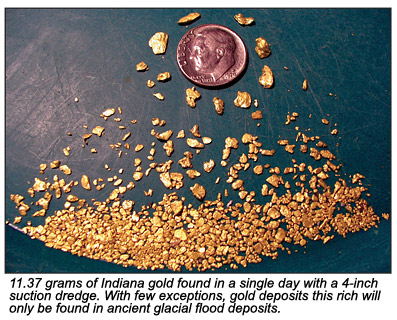 found in Indiana today was transported here from somewhere else. The closest hardrock deposits of gold are located in Ontario and northern Michigan, hundreds of miles to the north. Much of the gold from this northern source rock, as well as the ancient northern placer deposits, was stripped away by massive glaciers and moved southward into Indiana and other Midwestern states during the Ice Age.
found in Indiana today was transported here from somewhere else. The closest hardrock deposits of gold are located in Ontario and northern Michigan, hundreds of miles to the north. Much of the gold from this northern source rock, as well as the ancient northern placer deposits, was stripped away by massive glaciers and moved southward into Indiana and other Midwestern states during the Ice Age.
The time period when this action occurred is known as the Pleistocene Epoch, which took place over the last 2.1 million years. Throughout this time frame there have been warmer periods when the ice melted back and dropped its load of gravel and gold. These warm eras are known as interglacial periods. Fortunately, we live in one such warm interglacial period today. To get an idea of how massive and powerful these glaciers were, you might try to imagine that just 20,000 years ago my home in Northern Indiana would have been crushed underneath more than 5,000 feet of ice.
Glacial transport leads to a very different method of gold deposition than has occurred out West. In California for instance, there are vast mountain ranges that are imbued with veins of hard rock gold. The entire region is also considerably more geologically active than Indiana. There are forces at work there, even today, that free gold and move it downhill into the streams and rivers. The source for the gold is local, so it is an ongoing process that periodically replenishes the waterways and forms new placer deposits during every major flood event.
This is in stark contrast to Indiana, which is by comparison, somewhat stagnant geologically speaking. In the portion of the state that was previously glaciated, much of the terrain is relatively flat. The geological features in this part of the state were predominantly created by the glaciers themselves, forming new river valleys and 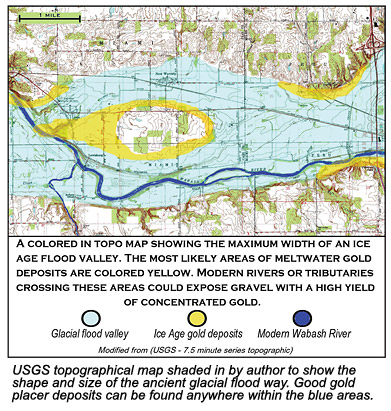 drainage networks as they moved and melted. Whatever topographical features or land forms existed before the Ice Age were largely erased by the onslaught of ice and its massive load of debris. Much of the state is now covered in glacial gravel deposits ranging from a few to several hundred feet in depth.
drainage networks as they moved and melted. Whatever topographical features or land forms existed before the Ice Age were largely erased by the onslaught of ice and its massive load of debris. Much of the state is now covered in glacial gravel deposits ranging from a few to several hundred feet in depth.
Unlike the conditions in play out West, it was runoff from the melting ice sheets that formed most of the richest placer deposits found in Indiana today. The gravel carried by these ice sheets contained gold that had been stripped out of Canadian deposits, which in turn were concentrated by the glacial meltwater. Because of the much slower erosion rate of this area, most of the gold-bearing placers that were laid down as the ice receded, a time when massive glacial floods ensued, are still in place today. Locating and identifying these ancient deposits are the keys to successful gold prospecting in this region.
The age of these glacial placer deposits can vary considerably, depending of which part of the state you are prospecting in. In the northern third of Indiana, the landscape that we see today was formed as little as 15,000 years ago—in the southern half it can be more than 120,000 years old. This is because the glaciers that shaped this landscape stopped advancing at different points in the state, and the more recent glaciations didn’t make it nearly as far south. Each subsequent advance and retreat of the ice forever altered the landscape. New drainage ways and river valleys were formed and persisted for thousands of years, only to buried or wiped clean by the next glacial advance. Not all the glacial advances came from the same direction, so gravel from many different parts of Ontario were mixed together with each new advance and then redeposited as the ice melted away.
Before I get to the nuts and bolts of prospecting in this type of environment, I want you to try to picture what it was like when these massive ice sheets were melting. The placer geology that we find here today is a direct result of this process, so the relevance will become more clear as you envision it. As the ice sheets advanced and retreated, they pushed huge linear piles of sand, clay and gravel up in front of them. These hills or “terminal 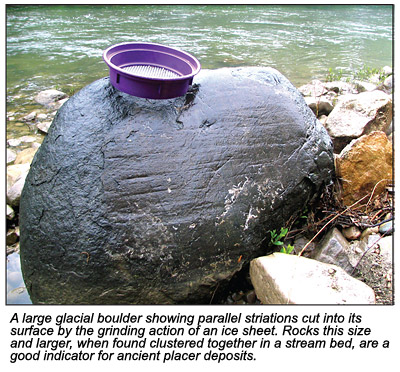 moraines” as they are called by geologists, acted as natural dams and held back huge quantities of melt water. This caused enormous lakes to form as meltwater continued to flow in from the remaining ice. The meltwater carried with it fine, ground up boulder clay and silt that settled onto the lake bottoms, in some cases to a depth of many feet. This fine-grained sediment formed a clay layer that blanketed the entire lake bottom and would later act as a false bedrock. Eventually, most of these lakes spilled over their dams and caused massive flooding, which carved out new drainage ways.
moraines” as they are called by geologists, acted as natural dams and held back huge quantities of melt water. This caused enormous lakes to form as meltwater continued to flow in from the remaining ice. The meltwater carried with it fine, ground up boulder clay and silt that settled onto the lake bottoms, in some cases to a depth of many feet. This fine-grained sediment formed a clay layer that blanketed the entire lake bottom and would later act as a false bedrock. Eventually, most of these lakes spilled over their dams and caused massive flooding, which carved out new drainage ways.
This process took place repeatedly, often separated by lengthy interglacial periods lasting thousands of years, giving the clay ample time to harden. Clay is very a common hardpan throughout the creeks and rivers of much of the state and even though it is different from bedrock, it can act in a similar way when it comes to how gold deposits are formed. Shallow bedrock can be found in some parts of the state, particularly in southern areas where the blanket of glacial gravel is much thinner than in the north. In the north, bedrock is present at a number of locations where violent meltwater flooding carved channels down into the overburden and often deeply into the bedrock itself.
Bedrock or clay layers are the essential habitats for coarse gold. These are the types of places that you should learn to recognize and seek out. When rapidly moving flood water travels across a hardpan surface, the heaviest components will be left behind in the pockets, drop-offs, crevices and other anomalies. The bedrock or compacted clay layer acts as a barrier, preventing anything heavy from going deeper, while allowing the lighter material to be swept onward.
One way to locate potential bedrock areas is by using a USGS “unconsolidated deposits” map. It will help you find areas with shallow overburden and the possibility of exposed bedrock. Well drilling records, which are 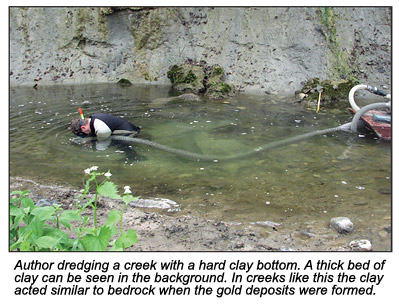 available online at the Indiana DNR website, are also very useful for determining depth to bedrock at a given location. Non-bedrock hardpan-like clay will not show up on the map, but often clay layers are described in the well drilling records.
available online at the Indiana DNR website, are also very useful for determining depth to bedrock at a given location. Non-bedrock hardpan-like clay will not show up on the map, but often clay layers are described in the well drilling records.
Unlike the Western States, many of the creeks and rivers in Indiana today simply don’t carry enough water force or velocity, even during flood stage, to free up and transport the more sizable chunks of gold. Yet, these same drainage systems did experience violent flooding when the ice sheets retreated. Megatons of gold-bearing gravel was sifted across the bedrock and hardpan bottoms of these very same waterways and valleys.
Using USGS topographical maps it is often very easy to see the extent and shape of a glacial outwash channel or sluiceway. Typically, there will be a comparatively small creek or river meandering its way down a relatively wide valley, the valley itself is the remnant of an Ice Age flood event. Some of these outwash valleys are more than a mile wide with the possibility of concentrated placer deposits anywhere in that valley, not just in the modern river itself.
The Wabash and Ohio rivers for example, two of the largest river systems in the US, were initially formed by glacial meltwater floods. These two rivers and many others like them, carry gold deposits, both ancient and modern, along their entire length. To sum it all up, glacial floods were unbelievably huge events, far more powerful than anything we have seen anywhere in North America in modern times. They were so massive and destructive that their flood waters quite literally formed the mighty Mississippi River itself into what we see today.
You should always bear this in mind when scouting a location. Try to picture the maximum extent of the glacial flood waters, because good gold deposits can be found anywhere within these outwash features. Study the topo maps to get an idea of how these old outwash valleys are shaped and look for places where the modern 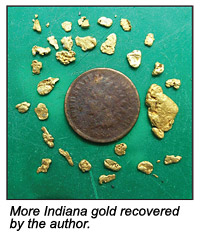 creek or river cuts through an inside bend or other likely feature in the valley. Look for other things as well, like any obstruction or raised area in the valley that would have acted like an island and caused the ancient flood waters to slow and drop out heavies.
creek or river cuts through an inside bend or other likely feature in the valley. Look for other things as well, like any obstruction or raised area in the valley that would have acted like an island and caused the ancient flood waters to slow and drop out heavies.
Identifying likely areas using a maps is the first step, but before you start sampling, you must be sure to find out who owns the property that you are interested in. Right now, we have it pretty good here in Indiana, and if we follow the rules laid out by the Department of Natural Resources, we can keep it that way. In Indiana, the prospecting rules state that “navigable waters” (those that are owned by state) are open to the public for “recreational mineral prospecting,” but you still must ingress and egress either from a public access point or have written permission from the person who owns the property where you intend to gain access. There is also a stipulation that if you do not have the riparian land owners permission, then you must stay a minimum of 50 feet or 1/4 or the stream width (whichever is less) away from that property.
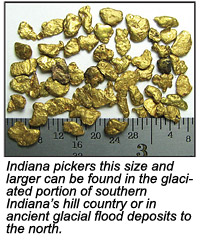 For non-navigable waters—those owned by private individuals—all you need is written permission from the property owner. Indiana does not have any seasonal limits or permits required for “recreational” prospecting and you may use up to a 5-inch suction dredge. Of course, state parks and state forests have their own rules, which you should check before prospecting.
For non-navigable waters—those owned by private individuals—all you need is written permission from the property owner. Indiana does not have any seasonal limits or permits required for “recreational” prospecting and you may use up to a 5-inch suction dredge. Of course, state parks and state forests have their own rules, which you should check before prospecting.
Once you have scouted out an ideal location—a location with some type of hard pan bottom—then there are basically two types of gold deposits that you can sample for. The most common is what I call the “modern” flood deposit. This is gold that has been concentrated by the modern river or stream that we see today. These deposits tend to range from very fine gold to small flakes and can be found throughout the gravel bars and inside bends of the modern waterway. Personally, I don’t look for modern flood deposits, because they usually aren’t worth the effort, and they contain virtually no nuggets. They are generally made up of the lighter sand and gravel that today’s weak floods can move, and it takes a lot of that fine gold to add up to anything substantial.
It should be noted that there are areas in southern Indiana where topography is such that modern floods can move larger gold and make great deposits. The modern flood deposits in Brown and Morgan counties and other areas that border the southern-most glacial boundary can be quite rewarding. These deposits are found mostly in the ravines and gulches of southern Indiana’s hill country. (I should also mention that I am making a generalization when I say there are two types of deposits; not every placer gold deposit in Indiana will fit neatly into these two categories.)
Since the modern flood deposits are much more common, I will talk about them briefly before moving on to the richer ancient placer deposits.
Modern placer deposits can be found in every river and stream in the glaciated portion of the state. You can use the same techniques to locate and sample them as you would to search for gold in a waterway out West. Modern gold deposits will be most concentrated in the gravel bars of inside bends, downstream from large rocks, below a streambed drop-off or downstream from any obstruction, such as a log or tree root wad.
There can occasionally be enough gold concentrated in a modern deposit to make it seem worthwhile and they are fairly easy to locate. It will almost always be fine gold or flakes, so don’t expect to find any nuggets or sizable pickers except in the hilly areas. The best modern deposits will be found in streams with a lot of vertical drop or a even in a small section of a stream that has a lot of elevation change.
Another area that can be good for modern placer gold is where a stream has meandered its way to the point where it is undercutting a hillside. Gold from glacial gravel in the hills can be concentrated by the stream into workable quantities.
I have a friend who works the lower reaches of the Wabash and Ohio rivers near the southwestern tip of the state with some success. He shovels the material from the sand bars that are common in that area into a beach box and recovers impressive amounts of ultra-fine gold. It is very similar to the gold deposits found along the beaches of the Pacific Northwest. The gold he is finding is all from modern floods and has probably traveled a hundred miles or more downstream from many tributaries that drain into these mighty rivers. Ultra-fine gold deposits can be found for hundreds of miles downstream from the glaciated regions, because this type of gold is easily moved by even moderate water flow.
Next month we will look at the second type of deposit—the “ancient” flood gravels. Although more difficult to locate, they can be extremely rewarding.
To be continued next month... 
Prospecting for Gold at Green Valley
In October, five of us decided to take an exploration trip into an area called Green Valley. This was perhaps ten miles upstream from where we had gone in September and the difficulty was access. One would think that based on the name it was an easily accessible area not far from a nearby town. This couldn’t be more wrong.
The Pothole Patch
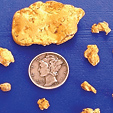 "Suh-wheet!" I exclaimed as I sprang to my feet and quickly pumped my detector coil high overhead to alert Smokey that I had just found a nugget.
"Suh-wheet!" I exclaimed as I sprang to my feet and quickly pumped my detector coil high overhead to alert Smokey that I had just found a nugget.
Prospecting for Diamonds in Kimberlite
 Kimberlite is very difficult for geologists to find, let alone prospectors and rock hounds. This is because kimberlite is rarely exposed on the surface and few people know how to identify the rock.
Kimberlite is very difficult for geologists to find, let alone prospectors and rock hounds. This is because kimberlite is rarely exposed on the surface and few people know how to identify the rock.
Detector Prospecting Accessories
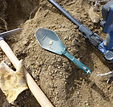 One of the first things to consider but that many people ignore is ergonomics. Prospecting for gold can involve long hours, often for days or weeks on end.
One of the first things to consider but that many people ignore is ergonomics. Prospecting for gold can involve long hours, often for days or weeks on end.Treasure Hunters Challenge FBI Over Dig for Civil War Gold
The father-son duo spent years combing this bit of Pennsylvania wilderness with high-end metal detectors, drills and other tools to prospect for a fabled cache of Civil War gold.
Montana Gold and Sapphires Revisited
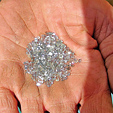 I had a chance to visit the operation in person and talk with Neal. I was very impressed and I think our readers could learn a lot about building up a commercial placer operation from scratch…
I had a chance to visit the operation in person and talk with Neal. I was very impressed and I think our readers could learn a lot about building up a commercial placer operation from scratch…
The Coolgardie Gold Mining Camp of Southern California
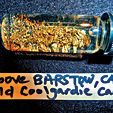 The area was mined intermittently from around 1900 to 1915, but was also mined in the late 1800s, with a total output valued at about $100,000, which is around $9.5 million at the current gold price.
The area was mined intermittently from around 1900 to 1915, but was also mined in the late 1800s, with a total output valued at about $100,000, which is around $9.5 million at the current gold price.
Subscription Required:
The Bawl Mill
• Our Readers Say
• Ask the Experts—Looking up mining claims on the Internet
• Ask the Experts—Access to mining claim across private land
• Ask the Experts—Best way to identify calaverite and sylvanite
• Legislative and Regulatory Update
• WSGS Releases New Geologic Maps
• Prospecting on the North Yuba
• Yesterday's Gold—Today's Mine
• Prospecting Australia—Part III Anatomy of a Nugget Patch in Western Australia
• Nevada Miners: Check Your Claim Markers
• Managers at Fault for Two Deaths at Meikle Mine
• Cold Water Gold
• River Dredging vs. Creek Dredging—Part I
• Melman on Gold & Silver
• Mining Stock Quotes and Mineral & Metal Prices
Free:
Ask the Experts—How do you determine how far a piece of gold has traveled in a stream?
• Testing Ores for Free Gold







